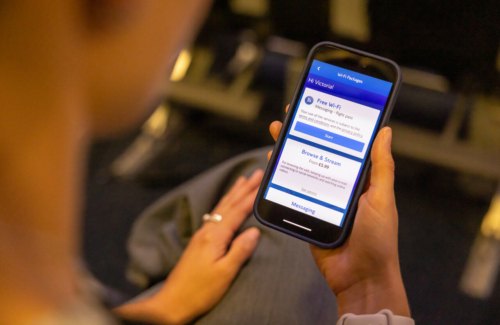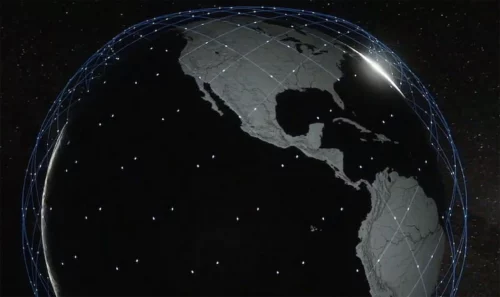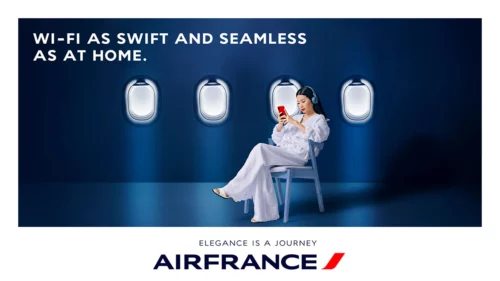2025 will be the year of free, unlimited inflight wifi
Links on Head for Points may support the site by paying a commission. See here for all partner links.
Airlines have long told of an era where connecting to friends, family and (dare I say it) work is as easy from 35,000 feet as it is on the ground. But this future has been surprisingly elusive – until now.
The last few months have seen airlines make a flurry of announcements when it comes to onboard wifi. Delta Air Lines, United Airlines and Air France have all announced that they are rolling out unlimited, free wifi to all customers this year whilst Cathay Pacific and Japan Airlines are amongst those offering it to business and first class customers.
Whilst we aren’t quite there yet, I predict that 2025 will be the year that fast, free and unlimited wifi becomes the norm. Airlines that haven’t committed to this will quickly find they have to.
Ground control to Major Tom
The promise of in-flight connectivity hasn’t always delivered. I’d warrant that almost anyone that has ever tried to connect to onboard wifi is familiar with wrestling glitchy sign-up pages and hour-long blackout zones. When you do connect, fickle speeds mean pages load normally one moment and then take minutes the next.
Whether or not in-flight wifi is usable is often a gamble, and an expensive one at that. Airlines frequently charging anything from £0 up to £25 for a full-flight voucher, with no guarantee of a functional service. Other airlines – such as easyJet – have no wifi whatsoever, a glaring omission in 2024.
To be fair, getting internet connectivity when you are flying at 550 miles per hour and at 35,000 feet is slightly more challenging than wiring your house up to the fibre network or connecting to 4G/5G network. Although ground-based solutions exist, they only work over land: for true end-to-end connectivity you need to rely on large, expensive satellites to bounce your signal back to earth.
A satellite is born
Boeing was the first to introduce an inflight connectivity service in 2000 when it launched Connexion by Boeing. United, Delta and American Airlines all signed up for the service with Lufthansa the international launch partner.
Initial speeds were ‘up to’ 20 Mbits/s – not bad for its day – but not great when you spread that across the volume of passengers on a single flight. Pricing was touted as $29.95 for long haul flights or $14.95 for shorter flights, with a metered option starting at $9.95 for the first 30 minutes and $0.25 for every minute thereafter.
If the pricing looks remarkably familiar to what you might pay on many airline today, don’t forget inflation has eroded its value. $29.95 in 2002 is roughly $50 now – far more than airlines now charge.
JetBlue was, I think, the first airline to offer free wifi to all customers when it rolled out its service in 2013. Other airlines have followed, often only giving passengers a time-limited taste of free wifi or only to business class passengers or status holders. British Airways rolled out free inflight messaging for Executive Club members earlier this year.
We are now at an inflection point. Over the past 12 months, we’ve seen more and more airlines commit to offering free wifi:
- Malaysia Airlines has offerered free unlimited wifi to all customers since November 2023
- Delta announced it was introducing free wifi in January 2023: it is rolling out to international routes this year
- Singapore Airlines rolled out unlimited free wifi to all Krisflyer members in June 2023
- Qatar Airways announced it would start installing free Starlink wifi this year, with the “entire modern fleet” to be completed within two years
- United announced a deal to install free Starlink wifi on more than 1,000 of its aircraft, starting in early 2025
- Air France also announced it would install free Starlink wifi from 2025
- Turkish Airlines says it will roll out free inflight wifi across its fleet by the end of 2025
.… and these are just the airlines (together with JetBlue) that have committed to free, unlimited wifi for everyone. The vast majority of other long haul airlines also offer free wifi for premium customers or status holders.
Smaller is better
What is enabling this sudden enthusiasm to offer fast, free wifi? The answer is technology.
You may have noticed that three of the airlines listed above have something in common: they are all installing something called Starlink.
Initially launched as an alternative to terrestrial broadband for those in remote and inaccessible areas, Starlink is a new satellite connectivity service offered by Elon Musk’s SpaceX that is now being offered to airlines.
In the past, inflight connectivity has relied on large, pricey satellites in geostationary orbit. That means that whilst the plane has been cruising at 550mph, it has been connecting to a satellite more than 20,000 miles away that orbits the earth in a fixed position, ie a single geographic area. Because of the distance, this introduced a significant lag to the browsing experience, whilst the satellite also acts as a bottleneck for the amount of data that can be processed.
Starlink turns this on its head. Rather than a handful of large, expensive satellites tens of thousands of miles away, it has lofted thousands of small, cheap satellites that orbit in a shell about 400 miles away. There are now more than 6,000 of these satellites spinning around the earth. Starlink is the first satellite internet constellation: OneWeb has since joined it whilst Amazon also plans to build out its own.
The benefits are myriad. The economies of scale of producing smaller satellites on mass over large bespoke ones mean it is cheaper to operate, whilst the lower orbiting altitude means there is less lag – about the same as you’d expect at home. This makes for a smoother experience.
Starlink also offers far, far more capacity than existing geostationary satellites. SpaceX’s second generation of satellites each offer around 75Gbps throughput: multiply that by thousands of satellites and you have 165Tbps for this generation alone.
Compare that to Viasat, whose three 1Tbps-capable Viasat-3 satellites provide global coverage but at only a fraction of the capacity – just 1.8% of what Starlink’s V2 constellation can offer.
Higher capacity, lower cost and low latency mean that airlines can now offer unlimited free wifi for customers in what Air France calls a “home-like” experience.
“Everything you can do on the ground, you’ll soon be able to do on board a United plane at 35,000 feet, just about anywhere in the world,” said United CEO Scott Kirby.
Starlink now counts seven airlines as its customers, including Air Baltic, Air France, Air New Zealand, Hawaiian Airlines, Qatar Ariways, United Airlines and Zipair. Other airlines and satellite constellations are sure to follow.
Which of the top 25 airlines in the world offer free wifi?
Here are the 25 largest airlines in the world, based on how many seats are available over a 12-month period according to Cirium.
Just two airlines on this list currently offer free, unlimited wifi to all passengers: JetBlue and Singapore Airlines (although you need to sign up for free KrisFlyer membership). A further five have announced their intention to rollout free wifi over the coming years: United Airlines, Delta Air Lines, Qatar Airways, Turkish Airlines and Air France. Four airlines offer no wifi at all.
- Aeroflot: unclear, given current Russian sanctions
- Air Canada: free messaging for Aeroplan members. $15 for a full-flight browsing pass.
- Air China: no wifi offered
- Air France: currently paid, free, unlimited wifi rolling out from 2025
- Alaska Airlines: free messaging for all customers. Full flight browsing is $8.
- American Airlines: wifi available from $10+.
- ANA: $21.95 for full-flight pass on long haul flights: free for first and business class passengers
- British Airways: free messaging for Executive Club members. Browsing available from £4.99 to £21.99.
- Cathay Pacific: free wifi for passengers in first and business class. $12.95+ for full-flight browsing.
- China Eastern Airlines: currently paid, a free trial is available on a first-come-first serve basis for 50 passengers per flight
- China Southern Airlines: currently paid, free wifi on some routes and for first and business class passengers
- Delta Air Lines: free wifi announced January 2023, currently rolling out internationally
- easyJet: no wifi offered
- Emirates: free messaging for Skywards members, free browsing for elite members depending on cabin class. Otherwise between $9.99 and $19.99 for full-flight access.
- IndiGo: no wifi offered
- JetBlue: free wifi for all customers
- KLM: free messaging for all customers. Paid browsing packages available.
- LATAM Airlines: wifi offered on some flights within Brazil, Chile, Colombia and Peru. Full flight browsing from $8; free for Elite members.
- Lufthansa: free messaging for Miles and More members; $8 for for full-flight pass on short haul flights and $27 on long haul
- Qatar Airways: 1 hour free high-speed wifi for Privilege Club members (unlimited for students). Full-flight browsing from $10. Free unlimited wifi coming to the entire modern fleet over the next two years.
- Ryanair: no wifi offered
- Singapore Airlines: free, unlimited wifi for passengers in Suites, first and business class and all KrisFlyer members
- Southwest Airlines: paid wifi available for $8 per device, per flight. Free for A-List Preferred Members and Business Select Customers.
- Turkish Airlines: free messaging for Miles & Smiles members, free browsing for business class passengers. Paid options available. Free, unlimited wifi to roll out by the end of 2025.
- United Airlines: currently from $8 for short-haul flights. Unlimited, free wifi rolling out from 2025.








 Rhys
Rhys 





Comments (157)